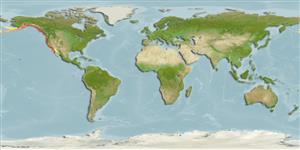Environment: milieu / climate zone / profondeur / distribution range
Écologie
marin démersal; profondeur 0 - 549 m (Ref. 6793), usually 15 - ? m (Ref. 27436). Temperate; 60°N - 22°N, 177°E - 109°W
Eastern Pacific: Bering Sea coast of Alaska to Cabo San Lucas, southern Baja California, Mexico. Occurrence in Nicaragua (Ref. 13613) needs validation.
Taille / Poids / Âge
Maturité: Lm ? range ? - ? cm
Max length : 41.0 cm TL mâle / non sexé; (Ref. 2850); âge max. reporté: 9 années (Ref. 72462)
Description synthétique
Clés d'identification | Morphologie | Morphométrie
Épines dorsales (Total) : 0; Rayons mous dorsaux (Total) : 86 - 102; Épines anales: 0; Rayons mous anaux: 67 - 81; Vertèbres: 38 - 40. Caudal rounded; pectorals rather large and pointed (Ref. 6885). Eyed side dull brown or tan irregularly mottled with dark; Dorsal, anal, caudal and anal fins black; blind side white to pale brown (Ref. 6885). Freshly caught males with dull orange spots and blotches (Ref. 6885). Young light olive green on eyed side, finely and sparsely speckled with brown, black, and orange, especially on fins (Ref. 6885).
Body shape (shape guide): fusiform / normal.
Found on sand bottoms (Ref. 2850). Young may occur at depth less than 9 m (Ref. 2850).
Distinct pairing (Ref. 205).
Eschmeyer, W.N., E.S. Herald and H. Hammann, 1983. A field guide to Pacific coast fishes of North America. Boston (MA, USA): Houghton Mifflin Company. xii+336 p. (Ref. 2850)
Statut dans la liste rouge de l'IUCN (Ref. 130435: Version 2025-1)
Menace pour l'homme
Harmless
Utilisations par l'homme
Pêcheries: commercial; pêche sportive: oui
Outils
Articles particuliers
Télécharger en XML
Sources Internet
Estimates based on models
Preferred temperature (Réf.
123201): 5.5 - 19.4, mean 10.3 °C (based on 1346 cells).
Phylogenetic diversity index (Réf.
82804): PD
50 = 0.5000 [Uniqueness, from 0.5 = low to 2.0 = high].
Bayesian length-weight: a=0.00977 (0.00418 - 0.02283), b=3.07 (2.86 - 3.28), in cm total length, based on LWR estimates for this (Sub)family-body shape (Ref.
93245).
Niveau trophique (Réf.
69278): 3.5 ±0.3 se; based on diet studies.
Generation time: 3.7 ( na - na) years. Estimated as median ln(3)/K based on 1
growth studies.
Résilience (Réf.
120179): Milieu, temps minimum de doublement de population : 1,4 à 4,4 années (K=0.30; tmax=11; tm=2.5).
Fishing Vulnerability (Ref.
59153): Low to moderate vulnerability (35 of 100).
🛈
Climate Vulnerability (Ref.
125649): Low vulnerability (8 of 100).
🛈
Nutrients (Ref.
124155): Calcium = 42.1 [21.2, 71.0] mg/100g; Iron = 0.353 [0.168, 0.598] mg/100g; Protein = 17.3 [15.1, 19.3] %; Omega3 = 0.528 [0.234, 1.062] g/100g; Selenium = 18.3 [10.4, 34.5] μg/100g; VitaminA = 13.4 [3.9, 42.1] μg/100g; Zinc = 0.517 [0.367, 0.717] mg/100g (wet weight);
